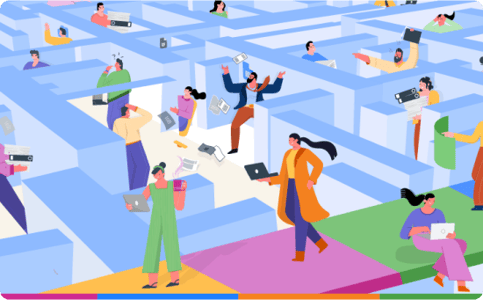
- >
- Application modernization>
- Top application modernization tools
Top Application Modernization Tools and Services Compared
Over the past few years, the landscape of application modernization has exploded with options. Every week, another platform promises to revolutionize how organizations transform their legacy systems. Organizations that have evaluated dozens of these solutions understand that choosing the right combination of application modernization tools and services often determines whether modernization initiatives succeed or become cautionary tales.
This selection process is particularly challenging because the market has evolved beyond simple migration utilities to comprehensive platforms that promise end-to-end transformation capabilities. Today's application modernization solutions encompass everything from low-code development platforms to AI-powered code analysis tools, each claiming to be the silver bullet for modernization challenges.
The reality is more nuanced. The most successful modernization initiatives combine multiple approaches, leveraging specialized application modernization services for complex transformations while using modern development platforms to accelerate new application creation. Understanding how these different categories of solutions work together is crucial for building an effective modernization strategy.
Understanding the Modern Application Development Ecosystem
The application modernization market has been segmented into several distinct categories, each addressing different aspects of the transformation journey. Rather than viewing these as competing solutions, successful organizations treat them as complementary tools that address different modernization challenges.
The Evolution of Development Platforms
Traditional application development required extensive coding, complex deployment processes, and significant ongoing maintenance overhead. Modern platforms have changed this paradigm by providing visual development environments, automated deployment capabilities, and built-in scalability features that dramatically reduce development time and complexity.
This shift represents more than just tooling improvements. It's fundamentally changing who can build applications and how quickly they can deliver business value. Business users with domain expertise can now create sophisticated applications without traditional programming skills, while professional developers can focus on complex business logic rather than routine development tasks.
The modernization implications are profound. Organizations can replace legacy applications with modern solutions much faster than traditional development approaches would allow, while simultaneously building internal capabilities for ongoing application evolution.
Service vs. Platform Considerations
When evaluating application modernization companies and their offerings, it's important to understand the distinction between modernization services and development platforms. Services typically provide human expertise for complex transformation projects, while platforms enable organizations to build capabilities internally.
Most successful modernization initiatives combine both approaches strategically. Complex legacy system transformations often require specialized expertise that application modernization services providers can deliver, while new application development can leverage modern platforms that enable faster delivery and easier maintenance.
The key is matching the right approach to each specific modernization challenge rather than trying to find a single solution that addresses every requirement.
Learn more: A complete guide to Application Modernization.
Comprehensive Platform Comparison: Low-Code Leaders
The low-code development platform space has become increasingly important for application modernization, allowing organizations to build modern applications rapidly while reducing dependence on traditional development resources.
Detailed Platform Analysis
| Platform | OutSystems | Mendix | Microsoft PowerApps | Appian | Kissflow |
|---|---|---|---|---|---|
|
Target Users
|
Professional developers, IT teams |
Business developers, IT professionals |
Business users, citizen developers |
Business process experts |
Citizen developers, business users, IT teams |
|
Development Approach
|
Visual, model-driven |
Visual, collaborative |
No-code/low-code hybrid |
Process-centric design |
AI-powered no-code/low-code |
|
Deployment Options
|
Cloud, on-premises, hybrid |
Cloud, on-premises |
Cloud (Microsoft 365) |
Cloud, on-premises |
Cloud-native |
|
Integration Capabilities
|
Extensive APIs, connectors |
Strong integration hub |
Deep Microsoft ecosystem |
Enterprise system focus |
Extensive API ecosystem, pre-built connectors |
|
Scalability
|
Enterprise-grade |
High scalability |
Depends on Microsoft plans |
Enterprise-focused |
Enterprise-scale (10 to 10,000+ users) |
|
Mobile Support
|
Native mobile apps |
Progressive web apps |
Mobile-responsive |
Mobile-optimized |
Mobile-responsive applications |
|
Pricing Model
|
Platform licensing |
Per-user subscription |
Per-user/per-app |
Platform + user licensing |
Transparent per-user pricing |
|
Learning Curve
|
Moderate to steep |
Moderate |
Low to moderate |
Moderate |
Very low (10-minute workflow creation) |
|
Enterprise Features
|
Advanced governance |
Strong collaboration |
Microsoft integration |
Workflow automation |
AI assistance, security, compliance (GDPR) |
Platform Strengths and Use Cases
Kissflow stands out as an AI-powered low-code/no-code platform specifically designed to bridge the gap between business users and IT teams. The platform excels in democratizing application development, enabling citizen developers to create sophisticated workflows and applications without coding expertise while providing powerful tools for IT teams to build enterprise-grade solutions.
What makes Kissflow unique is its dual approach: no-code capabilities allow process owners to automate business processes in a self-service manner, while low-code features enable IT teams to build comprehensive business applications. Customers typically see an 80% reduction in development time, and first-time users can create simple approval workflows in under 10 minutes using the drag-and-drop interface.
The platform combines intuitive drag-and-drop tools, AI-powered development assistance, enterprise-grade scalability, and strong security features. Kissflow integrates seamlessly with popular tools like Google Workspace, Salesforce, Trello, and QuickBooks, while supporting custom integrations through APIs. The platform is GDPR-compliant and scales effortlessly from teams of 10 to organizations with 10,000+ users, making it ideal for modernizing legacy workflows, automating business processes, and building new applications rapidly while maintaining security and compliance standards.
OutSystems excels in complex enterprise modernization scenarios where organizations need to replace sophisticated legacy applications with modern, scalable solutions. Their platform provides the depth and flexibility required for comprehensive application transformation while maintaining enterprise-grade performance and security.
The platform's strength lies in handling complex business logic, extensive integrations, and sophisticated user interfaces that match or exceed legacy application capabilities. This makes it particularly valuable for organizations modernizing mission-critical business applications.
Mendix offers a collaborative development environment that bridges the gap between business and IT teams. Their platform emphasizes rapid prototyping and iterative development, making it ideal for organizations that need to modernize applications while continuously refining requirements.
The platform's collaborative features enable business stakeholders to participate directly in application development, ensuring that modernized applications meet real business needs rather than just technical specifications.
Microsoft PowerApps provides seamless integration with the Microsoft ecosystem, making it a natural choice for organizations heavily invested in Microsoft technologies. The platform's strength lies in leveraging existing Microsoft investments while providing modern application development capabilities.
PowerApps excels when modernization involves extending or replacing applications that integrate heavily with Microsoft Office, SharePoint, or Dynamics systems.
Appian focuses specifically on business process automation and workflow optimization. Their platform is particularly strong for modernizing applications that involve complex approval processes, document management, or regulatory compliance workflows.
The platform's process-centric approach makes it ideal for organizations whose modernization goals include streamlining business operations alongside technical transformation.
Application Modernization Services Landscape
While development platforms enable organizations to build applications internally, many modernization initiatives require specialized expertise that application modernization services providers can deliver. Understanding the service provider landscape is crucial for complex transformation projects.
Enterprise Modernization Service Providers
The market for application modernization services includes everything from global consulting giants to specialized boutique firms, each bringing different capabilities and value propositions to modernization initiatives.
Global Systems Integrators like Accenture, IBM, and Deloitte offer comprehensive modernization services that combine deep industry expertise with extensive technology capabilities. These providers excel in large-scale, multi-year transformation programs that require coordination across multiple business units and technology domains.
Their strength lies in project management capabilities, industry-specific knowledge, and ability to coordinate complex implementations that involve multiple vendors and technologies.
Cloud-Native Specialists focus specifically on helping organizations adopt cloud-native architectures and development practices. These providers typically have deep expertise in containerization, microservices, and modern DevOps practices.
They excel in scenarios where modernization involves fundamental architectural transformation rather than simple application replacement.
Platform-Specific Service Providers specialize in particular development platforms or modernization approaches. These providers offer deep technical expertise in specific tools while understanding how to apply them effectively to real-world modernization challenges.
Service Provider Selection Criteria
Choosing the right application modernization services provider requires evaluating multiple factors beyond simple technical capabilities:
Domain expertise in your industry or business function can significantly impact project success. Providers who understand your specific regulatory requirements, business processes, or technical constraints can navigate challenges more effectively.
Technical capabilities should align with your modernization approach and target architecture. Providers should demonstrate proven experience with the technologies and platforms you plan to adopt.
Project methodology affects how smoothly implementations proceed and how effectively providers transfer knowledge to your internal teams. Look for providers who emphasize collaborative approaches and knowledge transfer.
Cultural fit influences how well external providers integrate with your internal teams and organizational culture. Successful modernization requires close collaboration that depends on good working relationships.
Software Modernization Companies: Specialized Solutions
Beyond general-purpose platforms and services, numerous software modernization companies provide specialized solutions for specific modernization challenges or technology stacks.
Legacy System Specialists
Mainframe modernization specialists like Micro Focus, IBM, and Modern Systems provide tools and services specifically designed for transforming COBOL applications, mainframe databases, and associated infrastructure.
These providers understand the unique challenges of mainframe environments and offer proven approaches for migrating business logic while preserving data integrity and business continuity.
ERP modernization specialists focus on transforming enterprise resource planning systems, often providing industry-specific solutions that address common modernization patterns in manufacturing, distribution, or professional services.
Custom application modernization providers specialize in transforming bespoke applications that were built internally or by previous vendors. These providers excel in reverse engineering existing systems and recreating functionality using modern architectures.
Technology-Specific Modernization Solutions
Cloud migration specialists provide tools and services specifically designed for moving applications to cloud platforms while optimizing them for cloud-native capabilities.
Database modernization providers focus on transforming data architectures, migrating from legacy database systems to modern cloud-native data platforms.
API modernization specialists help organizations expose legacy system functionality through modern APIs, enabling integration with new applications while preserving existing system investments.
Implementation Strategies and Best Practices
Successful application modernization requires more than just selecting the right tools and services. It demands systematic approaches that balance speed with risk management while ensuring that modernized applications deliver expected business value.
Platform Selection Framework
Requirements analysis should evaluate both current needs and future growth projections. Consider not just what applications you need to build today, but how your modernization platform will support ongoing business evolution.
Technical evaluation should include proof-of-concept development that validates platform capabilities against your specific requirements. Don't rely solely on vendor demonstrations or documentation.
Total cost of ownership analysis must consider not just platform licensing costs but also training, implementation, and ongoing maintenance expenses.
Organizational readiness assessment evaluates whether your team has the skills and processes needed to be successful with different platform approaches.
Service Provider Engagement Models
Fixed-price projects work well for well-defined modernization scope with clear requirements and deliverables. This model provides cost predictability while transferring implementation risk to service providers.
Time and materials arrangements offer flexibility for modernization projects where requirements may evolve during implementation. This model works well when organizations want to maintain close control over project direction.
Outcome-based pricing ties service provider compensation to specific business results rather than just project deliverables. This model aligns provider incentives with client success but requires careful metric definition.
Hybrid engagement models combine different approaches for different project phases. For example, fixed-price discovery and planning phases followed by time-and-materials implementation.
Risk Management and Quality Assurance
Proof-of-concept development validates platform capabilities and service provider competence before committing to full implementations. Invest in thorough POCs for critical modernization initiatives.
Incremental delivery enables early value realization while providing opportunities to adjust approaches based on real-world experience.
Comprehensive testing must address not just functional requirements but also performance, security, and integration testing across all modernized applications.
Change management planning ensures that users and stakeholders are prepared for new applications and processes.
Cost Analysis and ROI Considerations
ROI Calculation Factors
Development velocity improvements typically provide the most immediate ROI through faster application delivery and reduced development costs.
Operational efficiency gains emerge as modernized applications enable process automation, reduce manual effort, and improve user productivity.
Maintenance cost reductions compound over time as modern platforms require less ongoing technical maintenance than legacy applications.
Business agility improvements enable faster response to market opportunities and competitive threats, though these benefits can be harder to quantify.
Total Cost of Ownership Analysis
Direct costs include platform licensing, service provider fees, training expenses, and infrastructure requirements.
Indirect costs encompass opportunity costs from delayed modernization, productivity impacts during transitions, and ongoing support requirements.
Risk costs account for potential project failures, cost overruns, or business disruption during modernization.
Opportunity benefits include revenue growth from improved customer experiences, new business capabilities, or competitive advantages enabled by modernization.
Future Trends and Platform Evolution
The application modernization landscape continues evolving rapidly, with several trends shaping how organizations approach modernization and which tools they choose.
Emerging Technology Integration
Artificial intelligence integration is becoming standard across modernization platforms, enabling intelligent automation, code generation, and user experience optimization.
Low-code/no-code convergence blurs the lines between citizen developer tools and professional development platforms, enabling broader participation in application development.
Cloud-native architectures are becoming default assumptions rather than optional features, with platforms providing built-in support for containerization, microservices, and serverless computing.
API-first design emphasizes integration capabilities as core platform features rather than add-on functionality.
Market Consolidation and Specialization
Platform consolidation may reduce vendor choice while increasing the importance of vendor lock-in considerations and migration planning.
Specialized solution growth in vertical markets provides industry-specific capabilities that address unique modernization requirements.
Open source adoption increases in infrastructure and development tools while commercial platforms maintain advantages in business functionality and support.
User Experience Evolution
Collaborative development environments enable closer cooperation between business and technical stakeholders throughout the development lifecycle.
Visual development advancement makes sophisticated application development accessible to broader audiences while maintaining professional developer productivity.
Mobile-first approaches recognize that many applications are primarily accessed through mobile devices and design platforms accordingly.
Making Your Selection Decision
Choosing the right combination of application modernization solutions requires systematic evaluation that considers both immediate needs and long-term strategic objectives.
Decision Framework
Business requirements prioritization should guide platform selection more than technical features. Choose solutions that address your most critical business challenges rather than those with the most impressive feature lists.
Organizational capability assessment evaluates whether your team can successfully adopt and maintain different platform approaches.
Integration requirements analysis considers how new applications will work with existing systems and future technology investments.
Vendor stability evaluation assesses the long-term viability of platform providers and their commitment to continued innovation.
Implementation Planning
Pilot project selection allows validation of platform capabilities and service provider performance before larger commitments.
Phased rollout strategies enable gradual adoption while building internal capabilities and demonstrating value.
Success metrics definition establishes clear criteria for evaluating modernization outcomes and ROI achievement.
Exit strategy planning prepares for potential platform changes or vendor transitions that may become necessary over time.
Learn more: Kissflow Application modernization platform.
The Path Forward
The landscape of application modernization tools and services offers unprecedented opportunities for organizations ready to transform their application portfolios. Success depends on matching the right combination of platforms, services, and implementation approaches to your specific requirements while building internal capabilities for ongoing evolution.
At Kissflow, we understand that selecting the right modernization approach can be overwhelming given the vast array of options available. Our low-code platform exemplifies the principles of modern application development, enabling both technical and business users to build sophisticated applications without extensive coding. With visual development capabilities, seamless integrations, and enterprise-grade governance, Kissflow provides organizations with the flexibility to modernize legacy workflows and build entirely new applications rapidly while maintaining security and compliance standards. Experience how intuitive low-code development can accelerate your digital transformation journey.
Organizations ready to select the modernization tools and services that will transform their applications should start with clear business objectives, evaluate options systematically, and choose partners who understand their unique requirements and constraints.
Digitize your Job Safety Analysis to protect your people and operations.
Related Articles











